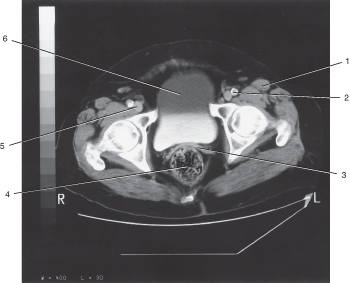CT Review :)

CT Review questions
- 1.
The kidneys are usually located anatomically between which vertebrae?
- A.
T6 AND L2
- B.
T12 AND L3
- C.
L2 AND L4
- D.
L3 AND S1
Correct Answer
B. T12 AND L3Explanation
The kidneys are usually located anatomically between the T12 and L3 vertebrae.Rate this question:
-
- 2.
As a solid-state CT detector measures transmitted radiation, it emits a proportional response in the form of a(n)
- A.
Digital signal
- B.
Quantity of gas ions
- C.
Analog signal
- D.
Modulation transfer function
Correct Answer
C. Analog signalExplanation
A solid-state CT detector measures transmitted radiation and emits a proportional response in the form of an analog signal. This means that the detector produces a continuous signal that represents the intensity of the transmitted radiation. An analog signal can have an infinite number of values within a given range, allowing for more precise measurements. This is in contrast to a digital signal, which only has discrete values. Therefore, the correct answer is analog signal.Rate this question:
-
- 3.
Ischemic brain tissue is identified as an infract core when cerebral blood volume (CBV) falls below
- A.
2.5 ml/100g
- B.
5.0 ml/100g
- C.
10.0 ml/100g
- D.
50.0ml.100g
Correct Answer
A. 2.5 ml/100gExplanation
Ischemic brain tissue is identified as an infract core when cerebral blood volume (CBV) falls below 2.5 ml/100g. This means that when the CBV drops below this level, it indicates a lack of blood flow to the brain tissue, leading to ischemia. Ischemia can result in tissue damage and cell death, which is why it is important to identify the infract core accurately.Rate this question:
-
- 4.
The period of peak hepatic parenchymal enhancement following rapid bolus injection of iodinated contrast is termed the
- A.
Equilibrium phase
- B.
Portal venous phase
- C.
Arterial phase
- D.
Nephrographic phase
Correct Answer
B. Portal venous phaseExplanation
The period of peak hepatic parenchymal enhancement following rapid bolus injection of iodinated contrast is termed the portal venous phase. This phase occurs after the arterial phase, where the contrast first enters the hepatic arteries, and before the nephrographic phase, where the contrast is excreted by the kidneys. During the portal venous phase, the contrast is delivered to the liver via the portal vein, resulting in increased enhancement of the hepatic parenchyma. This phase is important for evaluating liver lesions and assessing liver function.Rate this question:
-
- 5.
Number 1 corresponds to which of the following?
- A.
Illiopsoas muscles
- B.
Sartorius muscle
- C.
Gluteus minimus muscle
- D.
Rectus femoris muscle
Correct Answer
B. Sartorius muscleExplanation
The correct answer is the sartorius muscle. The sartorius muscle is the longest muscle in the human body and is located in the thigh. It runs diagonally across the front of the thigh and helps to flex and rotate the hip joint. It also helps to flex and rotate the knee joint.Rate this question:
-
- 6.
An image was produced with a 1.0mm aperture size and was displayed using a 512^2 matrix and a 15-cm DFOV. The voxel dimension for this image would be
- A.
0.29mm x 0.29mm x 1.0mm
- B.
02.9mm x 2.9mm x 1.0mm
- C.
3.4mm x 3.4mm x 1.0mm
- D.
0.29mm x 0.29mm x 1.0cm
Correct Answer
A. 0.29mm x 0.29mm x 1.0mmExplanation
The voxel dimension of the image would be 0.29mm x 0.29mm x 1.0mm. This can be determined by considering the aperture size, matrix size, and DFOV. The aperture size of 1.0mm indicates the thickness of each voxel. The matrix size of 512^2 indicates the number of voxels in the x and y directions. The DFOV of 15-cm indicates the physical size of the image in the x and y directions. Therefore, the voxel dimension can be calculated by dividing the DFOV by the matrix size in each direction, resulting in 0.29mm x 0.29mm. The thickness of each voxel remains unchanged at 1.0mm.Rate this question:
-
Quiz Review Timeline +
Our quizzes are rigorously reviewed, monitored and continuously updated by our expert board to maintain accuracy, relevance, and timeliness.
-
Current Version
-
Mar 21, 2023Quiz Edited by
ProProfs Editorial Team -
Nov 28, 2010Quiz Created by
Anim
- EEG Quizzes
- First Aid Quizzes
- GCP Quizzes
- Healing Quizzes
- Mammography Quizzes
- Medical Coding Quizzes
- Medical Science Quizzes
- Medical Term Quizzes
- Medical Terminology Quizzes
- Medical Training Quizzes
- Medical Vocabulary Quizzes
- MRI Quizzes
- Nuclear Medicine Quizzes
- Obstetrics And Gynecology Quizzes
- Pathology Quizzes
- Pathophysiology Quizzes
- Phlebotomy Quizzes
- Pulmonary Quizzes
- Syndrome Quizzes
 Back to top
Back to top


